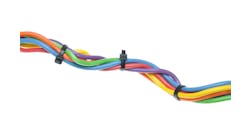The material and energy balances for the unit operation establish the flow ratio seen on the PFD. The numerator of the ratio is the manipulated flow and the denominator is a lead flow, typically a feed flow. Good measurement and control of the feed and manipulated flows are needed.
It is critical that a flow ratio not be used as the process variable for a PID controller. The result would be a process variable hitting the scale high limit and an incredibly high process gain for low flow excursions that causes the denominator to approach zero. The process variable would be too noisy and nonlinear for process control.
A good example of the extensive potential benefit of flow feedforward for a unit operation is the distillation column. Consider the direct material balance control scheme where the column temperature controller manipulates distillate flow (D) that is the preferred choice provided the distillate flow is not significantly less than the reflux flow (R) or bottoms flow (B). The steam flow is set to provide a vapor flow (V) up the column for a given production rate. For flow feedforward, we potentially have ratio control of D/F, R/F, B/F, and V/F. The flow feedforward signal is the desired ratio multiplied by the feed flow. Dynamic compensation is applied to the feedforward as needed so that the effect of the change in manipulated variable arrives at the control point in the column (e.g., tray for temperature control and sample point for composition control) at the same time as the effect of the change in feed. For startup, the composition and temperature controllers stay in manual on flow ratio control until the column reaches operating conditions. The level loops go on automatic to keep the sump and receiver levels within limits.
In order for Operations and Process Technology to be able to monitor and improve the ratio control, the desired ratio (e.g., ratio SP) must be adjustable and the actual ratio (e.g., ratio PV) must be visible. The lead flow multiplied by the desired ratio is the manipulated flow controller setpoint. In order for the process controller (e.g., composition, level, pressure, or temperature PID) to be able to correct the ratio, a feedforward summer is used to bias the setpoint of the manipulated flow controller. When the process controller is in manual, the bias correction should be zero enabling straight flow ratio control.
A feedforward summer has proven to be more practical than a feedforward multiplier for many reasons. The bias correction afforded by the summer is consistent with the bias correction by model predictive control (MPC) trajectory based on a controlled variable feedback measurement and the bias correction of an artificial neural network (ANN) based on an at-line or offline analyzer feedback measurement. The bias from feedforward summer compensates for offsets and rangeability limits in the flow measurements. The scaling is typically -50% to +50% of the manipulated flow measurement scale. The summer avoids the introduction of nonlinearity via a multiplier and the associated complexity of scaling of the multiplier. Most people don't realize that except for plug flow volumes, the change in process gain with flow is inherently compensated by the change in process time constant with flow so far as controller tuning is concerned. The use of a feedforward multiplier would necessitate a controller gain to be inversely proportional to the controller output for tight non oscillatory feedback control.
The feedforward should be setup to protect against erratic behavior, excessive noise, and dropout of signals when a flow measurement drops below a low flow rangeability limit. This is a common problem for differential head and vortex meters.
If the lead flow drops below the rangeability capability, a lead flow low limit may be imposed to provide a constant low lead flow for more consistent feedforward action and to prevent division by zero in the computation of the actual ratio (e.g., ratio PV). If filtering of the lead (feed) flow cannot sufficiently eliminate noise, the lead flow SP can be used instead of the lead flow PV for the feedforward.
If the manipulated flow drops below its low rangeability capability, the combined feedforward and feedback signal should go to a signal characterizer and then to the control valve rather than the manipulated flow controller setpoint. The characterizer output provides a valve signal proportional to the desired manipulated flow by going from the Y axis to X axis of the valve's installed flow characteristic.
For more information on the benefit of flow feedforward see the March-April 2011 InTech article "Feedforward control enables flexible, sustainable manufacturing." Now that we have supporting technical information, here is the checklist:
•(1) Does the lead (e.g., feed) flow and manipulated flow have enough rangeability for flow ratio control for automated startups and flexible manufacturing?
•(2) Is a low limit imposed on the lead flow to prevent erratic behavior and dropout?
•(3) Is the lead flow PV filtered to prevent flow measurement noise from causing valve dither?
•(4) Is the lead flow SP used instead of the flow PV for an excessively noisy flow measurement?
•(5) Is dynamic compensation applied to ensure the effect of the change in manipulated flow arrives at the same control point at the same time as the effect of the change in lead flow?
•(6) Can Operations and Process Technology adjust the desired ratio and see the actual ratio?
•(7) Can Operations run on ratio control with no process feedback correction for startup, abnormal operation, and process measurement failure (e.g., temperature or analyzer failure)?
•(8) Is a feedforward summer scaled used to give a -50% to +50% of manipulated flow measurement scale as a bias for feedback correction?
•(9) Does the manipulated flow go off of cascade flow control when the manipulated flow drops below its low flow rangeability limit?
•(10)When off of cascade control, does the manipulated flow signal go to a signal characterizer to compensate for the valve's installed flow characteristic before going to the valve?




